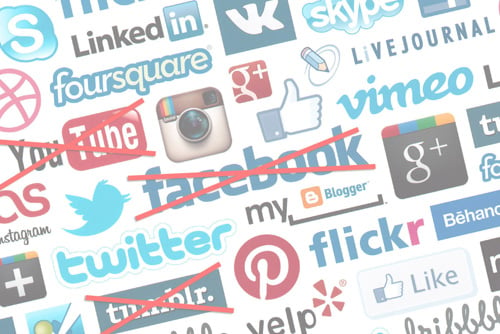Nobody wants to be the “bearer” of bad news. And so, many businesses believe they’re constantly “WOWing” customers while the opposite is actually happening.

image source: https://www.flickr.com/photos/sylvainkalache/
We see poor customer service all around us: an inattentive store clerk or an unconcerned receptionist. It’s something we grow to accept and understand as a fact of life. But it doesn’t have to be this way.
Case in point:
I was out shopping last week at a large department store. As I approached my turn at the checkout, the sales clerk enthusiastically asked, “Have you found what you were looking for today?”
I said that I didnt – I was looking for a brand of shampoo that I saw a few weeks ago which wasn’t there anymore. Since that was the reason for going to the store in the first place, it was all I could think about.
The clerk looked a bit thrown off, paused, said “ok” and proceeds to scan my items. At this point I dropped the issue as it became clear that it wasn’t her fault – no one told her how to behave in this situation.
But the question of why this is going on still remains. And it’s not easily answered.
Customer service, just like any other industry has been hit with a number of changes. Accelerated internet usage, generational behavioral shifts, social media and mobile have all caused companies to rethink how they’re supporting customers.
How bad is your customer service, really?
On average, about 80% of businesses believe they deliver great service (while only 8% of customers agree on that). With such a sweeping divide between expectations and reality, it’s difficult to point to a single reason why customers feel so let down.
Part of the issue is that large businesses dominate our day-to-day life – by the nature of their size, they choose not to invest in customer service. They have enough market clout and know that no matter how mad you get, you’ll still have to deal with them.
Chances are – you don’t have a monopoly over your market, so once a chunk of your customers run for the hills, it may be too late to make any meaningful, structural changes.
So here are some warning signs to watch out for – and keep your customer service on the right track:
1. You believe customer service and marketing are fundamentally different.

image source: royalty free
Many of today’s corporations split marketing and customer service activities into different categories. CEOs and top management still hold authority to affect both, and employees on the lower rungs aren’t inclined to break down pre-established business silos.
Yet marketers need insight from support agents to understand what matters to customers. Customer expectations need to be set with inputs from support and marketing departments – so that one can notify the other when inadequate or misleading expectations are being communicated.
Yet many organizations still view their support and social marketing channels as separate. Since customer service agents are customer experts, marketers need their expertise to help with content creation and other inbound marketing duties.
2. You want every customer interaction to be quick & efficient.

image source: royalty free
While it’s true that no one wants to wait around for support, “faster” in and of itself does not necessarily mean “better”. While being quick is good, customers care much more about competent and helpful service. They are definitely willing to wait longer to receive human service and get issues solved to their liking.
Whether we’re talking to a friend or asking a stranger to help us find the right item at a store, our brain processes these interactions much the same way. Just as we’d be put off by a rude or thoughtless response – we’d similarly be put off by an answer that comes unexpectedly quick or too late. It’s all about finding a happy, human medium.
3. You don’t hear a lot of ideas or feature requests from customers.

image source: royalty free
Customers usually try out a product first and reach out with a suggestion second. When you don’t get a lot of feature requests, chances are customers aren’t using your product to begin with or you aren’t providing them with a way to voice their feedback. In either case – it’s bad news.
Over time, this can be a source of disengagement between your company and customers. You won’t know how they’re using your product – and later – you’ll lose track of pressing issues they’re facing. Before you know it, you’re spending more on customer acquisition while “leaking” loyal customers.
4. When you do hear back from customers, they’re usually unhappy.

image source: royalty free
Even though you hear from about a fraction of your dissatisfied customers, hearing about problems constantly could be a definite red flag. It’s a sign that customers are running into life-threatening issues and need help ASAP. It’s also a sign they’re unable to suggest improvements or talk about anything else but the problem.
If your Facebook or Twitter account lights up when you run into a bug or an outage, it could be due to:
- Your support options are inaccessible (ie: customers can’t reach you through email, so they go to Twitter)
- Your self-service or engagement is lousy – customers are having difficulty finding information on your site
- Your support options are too limited, concentrating issues to one support channel.
5. Most of your customers aren’t repeat customers.

image source: royalty free
People typically don’t switch companies for the fun of it. They do it when customer service goes downhill, their demands aren’t being met and a competitor next door over takes notice.
There’s little desire to fill out long surveys, leave feedback or contact support at all (unless it’s a life-threatening issue). People don’t like to let businesses know of poor service – they just leave and don’t come back.
You end up with these unseen problems that you never know about and never act on because customers won’t tell you about them. And, since acquiring customers costs six to seven times as much as keeping existing ones happy, it’s inevitable that customer acquisition slowly eat into your profits.
6. You’re obsessed with collecting “likes” and “fans”.

image source: royalty free
If you’re going after a picture-perfect online image complete with likes, fans and flawless 5-star reviews, you’re probably not directing your efforts where you should.
It’s not enough to greet everyone with a smile and entice users with free perks after sign up. This sort of behavior may work if you’ve established a luxury brand where such perks are expected in your industry. You’ll be better off investing in customer service improvements and training for employees.
7. Service reps have little authority to make decisions.

image source: royalty free
When customer service reps need to get approval from upper management in order to offer any sort of discount, refund or to close accounts, it doesn’t sit well with either your customer or your support agents.
This can hemorrhage into a bigger problem: unmotivated and burned out support personnel. Something you definitely don’t want – you need them handling issues with empathy, efficiency and a positive attitude.
8. When you solve an issue, it’s out of sight & out of mind.

image source: royalty free
What happens when an issue is resolved? Do you breathe a sigh of relief, close it up and forget about it for good? Or do you have an archive system or a way to tag certain emails?
When you don’t have a record of past conversations or the ability to organize them you end up losing track of important information your customers readily give you.
9. You end up transferring customers to many departments.

image source: http://www.usbanksupply.com/
Anyone who deals with customers should be able to resolve issues without throwing the hot potato to somebody else. Agents need to be able to understand the full service cycle that a customer experiences – and how it affects them.
Once management gets into the habit of segmenting support tasks among numerous team members, it becomes difficult to undo this process. In the end, customers suffer.
10. You are comfortable with the way things are.

image source: royalty free
Customer happiness isn’t reached by getting comfortable. Sometimes you must push customers and your support agents out of the comfort zone – including acting on support trends and increasing productivity of your support agents.
Besides, knowledge is power – what we don’t know can end up hurting us. Customer knowledge is information that is directly usable and can be acted upon today. Things that slip past your radar can become increasingly problematic (and difficult to pinpoint) as time goes on.
In the end, customer service has changed in leaps and bounds. Yes, it might have gotten worse overall, but then again – customers also demand more. While a complicated set of factors change what customer service means to all of us, good old empathy and understanding will go a long way in making customers happy.
This post was originally published at http://helprace.com/blog/10-signs-your-customer-service-probably-sucks




When you say “But the question of why this is going on still remains. And it’s not easily answered.”, and then go on to offer 10 reasons for ineffectual customer service, these are examples of deficient stakeholder-centricity, culturally, strategically, and process-wise. And, there are a good many more reasons why customer service, and more broadly customer experience, are commodity-oriented in most organizations.
The vast majority of companies have difficulty getting out of their own way. Stakeholder-centric leaders don’t behave this way. What you experienced at the department store would likely not be repeated at Costco, Wegman’s, Trader Joe’s, Whole Foods, Publix, The Container Store, or IKEA.